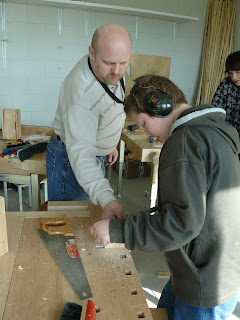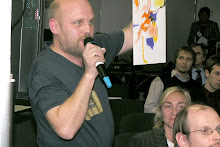CHAMBER MUSIC AND ART WITH TÕNU TALVE
I walked along the autumn Street, and then along the Spring Street, and arrived at the Westholm Gymnasium, to the concert of the Tallinn Chamber Orchestra; Tõnu Talve´s open painting session being part of the program.
There was a screen above the stage of the large hall of the school. The orchestra had been placed in front of it. On the right hand was a canvas on the easel and paints for the artist. Children were gathering. The musicians tuned their instruments and started to play, Händel´s Concerto grosso G-sharp op 6 No 1; then The Passion by Erkki Sven Tüür and finally Händel´ s Concerto grosso B-sharp op 6 No 7. The artist stepped on the stage and started to paint.
Listening to Händel in this beautiful hall with a high ceiling, I was thinking of the time of Baroque, when playing music was first and foremost a social event; of Baroque castles, where the walls and vaults were decorated with mythological compositions by Pietro da Cortona and other artists. The theatrical era of Baroque turned everything into a play with elements of music and carnival. The artists at that time must have been perfect psychologists and salesmen, making their work fascinating through the effects of light and shade, illusion, and the human body rendered in a variety of poses. Also through the dimensions that sometimes completely deceive the human eye, which may take a courtier, leaning on the balustrade on the other side of a hall, for a real person.
Talve was working simultaneously on two canvases. I recognised his favourite motif, the lighthouse, on one picture. The schoolboys were snickering a little bit at the movement of his hand falling into the rhythm of the music. The cold colours and deserted backgrounds of Talve´s paintings sometimes make me think of Dali´s dream fantasies, maybe of a giraffe that might suddenly emerge out of nothingness.
A cameraman was walking around and filming everything. Through his camera the action was projected on the screen: the artist´s hand, the bowing violinists, or faces of the children, who were watching and listening.
I was contemplating, that different arts approach each other actively today. The other characteristic strive is: to make a film about everything, that is going on. (It is no secret that almost each artstudent nowadays dreams of a film director´s career.) These two things have something in common with the Baroque culture. Talve’s show was simultaneously perceived as in film and live, which enriched the experience in many different ways: one could see the picture as a whole, and closeups of the texture at the same time, as well as other aspects. In a way, it gave the whole thing kind of a Pollockian spontaneity, a feeling that perhaps the process is sometimes more important than the picture, and a possibility to look at the picture like at a document registering everything, that the artist has done in the process of painting.
One could also look at the show as a collage, that speculates with different social values and meets the viewer’s interest. While the postmodernist architecture is borrowing many different tricks from the entertainment, why cannot the painting do the same? The many-sided use of audio-visual means at the Westholm gymnasium was certainly very inventive and inspiring.
Later I went to another concert at a different school, where St Paul’s Suite op 29 by Holst was played, as well as Heino Eller’s Five pieces for the string orchestra, and finally Bela Bartok’s Romanian dances.This very beautiful and expressive program inspired the artist to choose colors, that reminded of the warm sunshine in a southern country. So Talve showed us, how a painter takes the immediate atmosphere that surrounds him while painting, whether he really thinks about it or not. Music inspires him, and the picture that he in painting, inspires the audience, who has a chance to test one’s susceptibility, and takes an original experience home with him.
VAPPU THURLOW, art critic.
I walked along the autumn Street, and then along the Spring Street, and arrived at the Westholm Gymnasium, to the concert of the Tallinn Chamber Orchestra; Tõnu Talve´s open painting session being part of the program.
There was a screen above the stage of the large hall of the school. The orchestra had been placed in front of it. On the right hand was a canvas on the easel and paints for the artist. Children were gathering. The musicians tuned their instruments and started to play, Händel´s Concerto grosso G-sharp op 6 No 1; then The Passion by Erkki Sven Tüür and finally Händel´ s Concerto grosso B-sharp op 6 No 7. The artist stepped on the stage and started to paint.
Listening to Händel in this beautiful hall with a high ceiling, I was thinking of the time of Baroque, when playing music was first and foremost a social event; of Baroque castles, where the walls and vaults were decorated with mythological compositions by Pietro da Cortona and other artists. The theatrical era of Baroque turned everything into a play with elements of music and carnival. The artists at that time must have been perfect psychologists and salesmen, making their work fascinating through the effects of light and shade, illusion, and the human body rendered in a variety of poses. Also through the dimensions that sometimes completely deceive the human eye, which may take a courtier, leaning on the balustrade on the other side of a hall, for a real person.
Talve was working simultaneously on two canvases. I recognised his favourite motif, the lighthouse, on one picture. The schoolboys were snickering a little bit at the movement of his hand falling into the rhythm of the music. The cold colours and deserted backgrounds of Talve´s paintings sometimes make me think of Dali´s dream fantasies, maybe of a giraffe that might suddenly emerge out of nothingness.
A cameraman was walking around and filming everything. Through his camera the action was projected on the screen: the artist´s hand, the bowing violinists, or faces of the children, who were watching and listening.
I was contemplating, that different arts approach each other actively today. The other characteristic strive is: to make a film about everything, that is going on. (It is no secret that almost each artstudent nowadays dreams of a film director´s career.) These two things have something in common with the Baroque culture. Talve’s show was simultaneously perceived as in film and live, which enriched the experience in many different ways: one could see the picture as a whole, and closeups of the texture at the same time, as well as other aspects. In a way, it gave the whole thing kind of a Pollockian spontaneity, a feeling that perhaps the process is sometimes more important than the picture, and a possibility to look at the picture like at a document registering everything, that the artist has done in the process of painting.
One could also look at the show as a collage, that speculates with different social values and meets the viewer’s interest. While the postmodernist architecture is borrowing many different tricks from the entertainment, why cannot the painting do the same? The many-sided use of audio-visual means at the Westholm gymnasium was certainly very inventive and inspiring.
Later I went to another concert at a different school, where St Paul’s Suite op 29 by Holst was played, as well as Heino Eller’s Five pieces for the string orchestra, and finally Bela Bartok’s Romanian dances.This very beautiful and expressive program inspired the artist to choose colors, that reminded of the warm sunshine in a southern country. So Talve showed us, how a painter takes the immediate atmosphere that surrounds him while painting, whether he really thinks about it or not. Music inspires him, and the picture that he in painting, inspires the audience, who has a chance to test one’s susceptibility, and takes an original experience home with him.
VAPPU THURLOW, art critic.








































.JPG)
.jpg)








